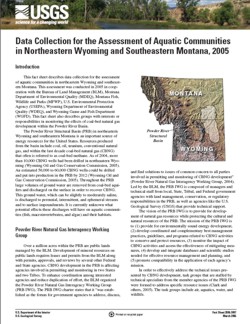 |
This fact sheet is in Adobe Acrobat® Portable Document Format (PDF). You will need Adobe Acrobat Reader®, version 6 or higher, to view or print the PDF. If you don't already have this free viewing software or need to upgrade your version, download Adobe Acrobat Reader®. Users with visual disabilities can visit http://access.adobe.com/ for conversion tools and information to help make PDF files accessible. The fact sheet is also available from USGS Maps and Publications.
- View or download the PDF (939 kb)
Introduction
This fact sheet describes data collection for the assessment of aquatic communities in northeastern Wyoming and southeastern Montana. This assessment was conducted in 2005 in cooperation with the Bureau of Land Management (BLM), Montana Department of Environmental Quality (MDEQ), Montana Fish, Wildlife and Parks (MFWP), U.S. Environmental Protection Agency (USEPA), Wyoming Department of Environmental Quality (WDEQ), and Wyoming Game and Fish Department (WGFD). This fact sheet also describes groups with interests or responsibilities in monitoring the effects of coal-bed natural gas development within the Powder River Basin.
The Powder River Structural Basin (PRB) in northeastern Wyoming and southeastern Montana is an important source of energy resources for the United States. Resources produced from the basin include coal, oil, uranium, conventional natural gas, and within the last decade coal-bed natural gas (CBNG) that often is referred to as coal-bed methane. As of 2004, more than 10,000 CBNG wells had been drilled in northeastern Wyoming (Wyoming Oil and Gas Conservation Commission, 2005). An estimated 50,000 to 60,000 CBNG wells could be drilled and put into production in the PRB by 2012 (Wyoming Oil and Gas Conservation Commission, 2005). Throughout the PRB large volumes of ground water are removed from coal-bed aquifers and discharged on the surface in order to recover CBNG. This ground water, which can be slightly to moderately saline, is discharged to perennial, intermittent, and ephemeral streams and to surface impoundments. It is currently unknown what potential effects these discharges will have on aquatic communities (fish, macroinvertebrates, and algae) and their habitats. |


